
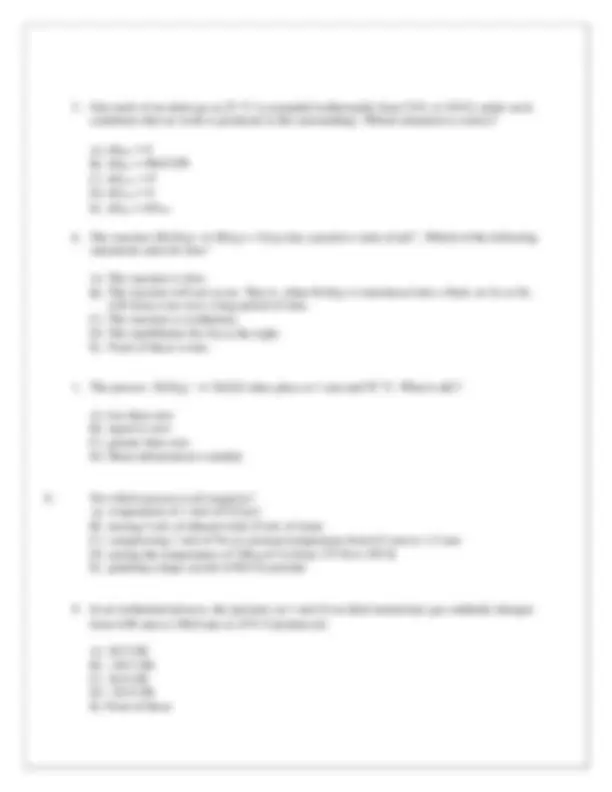
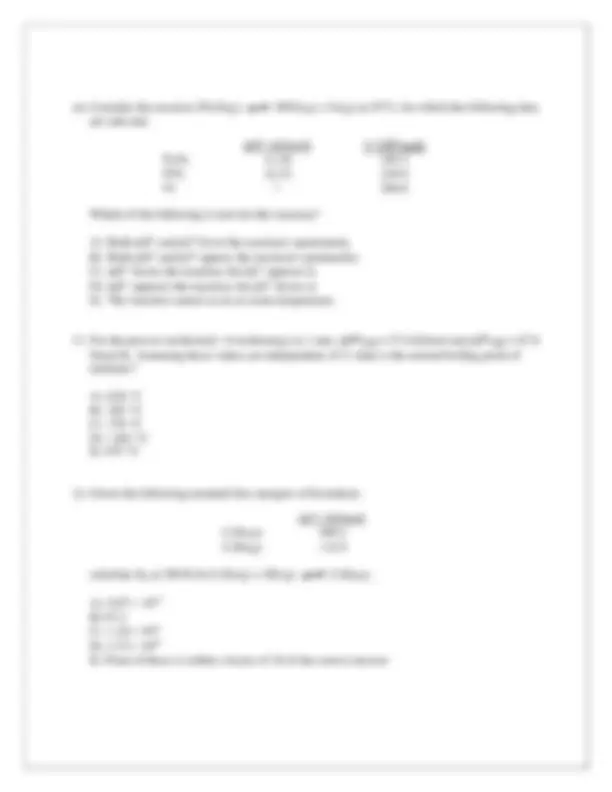
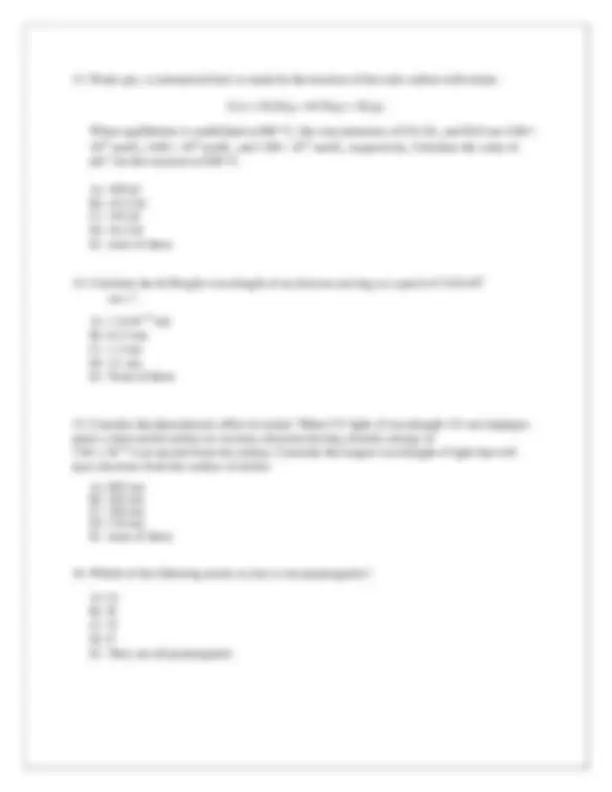
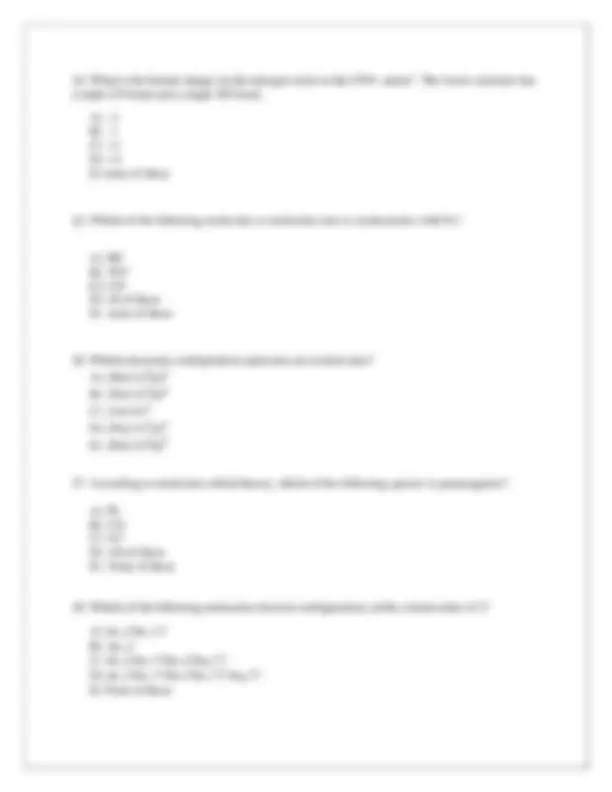

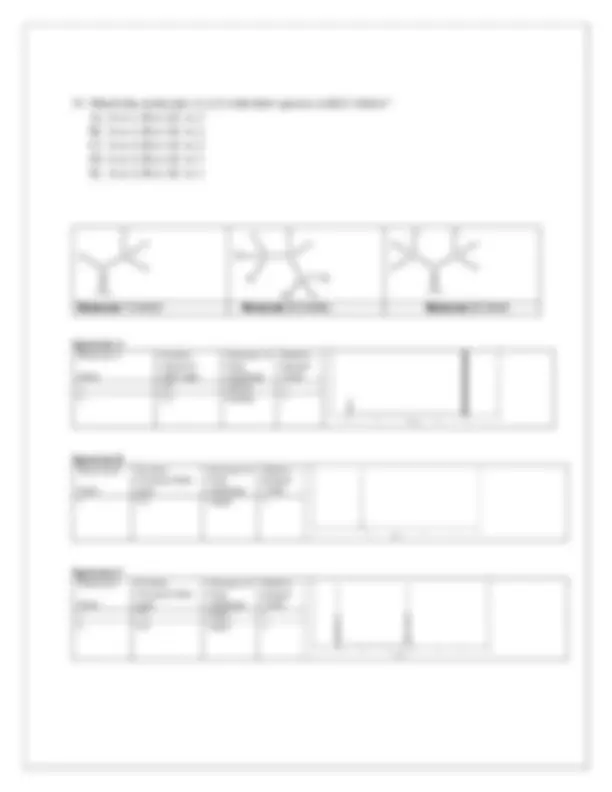


Study with the several resources on Docsity

Earn points by helping other students or get them with a premium plan


Prepare for your exams
Study with the several resources on Docsity

Earn points to download
Earn points by helping other students or get them with a premium plan
Community
Ask the community for help and clear up your study doubts
Discover the best universities in your country according to Docsity users
Free resources
Download our free guides on studying techniques, anxiety management strategies, and thesis advice from Docsity tutors
CHEMISTRY 1604.001 GENERAL CHEMISTRY (INTENSIVE) PRACTICE FINAL EXAM 2022CHEMISTRY 1604.001 GENERAL CHEMISTRY (INTENSIVE) PRACTICE FINAL EXAM 2022CHEMISTRY 1604.001 GENERAL CHEMISTRY (INTENSIVE) PRACTICE FINAL EXAM 2022CHEMISTRY 1604.001 GENERAL CHEMISTRY (INTENSIVE) PRACTICE FINAL EXAM 2022
Typology: Exams
1 / 12

This page cannot be seen from the preview
Don't miss anything!







395.0 g of water ( c = 4.18 J/g·°C) at 22.5 °C. The final temperature of the water is 24.5 °C.
Which metal was used?
A) Aluminum ( C = 0.89 J/g·°C)
B) Iron ( C = 0.45 J/g·°C)
C) Copper ( C = 0.20 J/g·°C)
D) Lead ( C = 0.14 J/g·°C)
E) None of these
liquid is 43.8 kJ/mol at 65 °C. Calculate w.
3 J
3
J
E) None of these
different pathways. The first pathway is A (3.00 atm, 20.0 L) to C (1.00 atm, 20.0 L) to D
(1.00 atm, 50.0 L); and the second pathway is A (3.00 atm, 20.0 L) to B (3.00 atm, 50.0 L) to
D (1.00 atm, 50.0 L). In each case, the gas is taken from state A to state D. Calculate ∆HABD.
A) 225 L·atm
B) – 225 L·atm
C) – 25 L·atm
D) – 475 L·atm
E) 25 L·atm
H ° (kJ/mol)
Cl 2 ( g ) 2Cl( g ) 242.
I 2 ( g ) 2I( g ) 151.
ICl( g ) I( g ) + Cl( g ) 211.
I 2 ( s ) I 2 ( g ) 62.
A) – 211 kJ/mol
B) – 14.6 kJ/mol
C) 16.8 kJ/mol
D) 245 kJ/mol
E) 439 kJ/mol
are relevant:
H °f (kJ/mol) (^) S ° (J/K•mol)
Which of the following is true for this reaction?
A) Both H ° and S ° favor the reaction's spontaneity.
B) Both H ° and S ° oppose the reaction's spontaneity.
C) H ° favors the reaction, but S ° opposes it.
D) H ° opposes the reaction, but S ° favors it.
E) The reaction cannot occur at room temperature.
J/mol·K. Assuming these values are independent of T , what is the normal boiling point of
moleene?
G°f (kJ/mol)
C 2 H 2 ( g ) 209.
C 2 H 6 ( g ) – 32.
calculate K p at 298 K for C 2 H 2 ( g ) + 2H 2 ( g ) C 2 H 6 ( g ).
31
42
E) None of these is within a factor of 10 of the correct answer.
C( s ) + H 2 O( g ) CO( g ) + H 2 ( g )
When equilibrium is established at 800 °C, the concentrations of CO, H 2 , and H 2 O are 4.00
G ° for this reaction at 800 °C.
A) 109 kJ
B) – 43.5 kJ
C) 193 kJ
D) 16.3 kJ
E) none of these
6
cm s
.
A) 1.3x
nm
B) 0.13 nm
C) 1.3 nm
D) 13. nm
E) None of these
upon a clean nickel surface in vacuum, electrons having a kinetic energy of
7.04 x 10
eject electrons from the surface of nickel.
A) 895 nm
B) 282 nm
C) 244 nm
D) 110 nm
E) none of these
A) Li
E) They are all paramagnetic
of the Schrodinger wave equation for the hydrogen atom?
n l ml ms
have sp
3 hybridization and tetrahedral geometry?
B) CCl 4
C) ICl 4
D) XeF 4
E) all of these
A) NO 2 B) SO 2 C) CO 2 D) all of these E) none of these
2 - ), nitrate ion (NO 3
sulfur trioxide molecule (SO 3 ). Which of them can be best represented by two or more
resonance structures?
2 -
2 - and SO (^3)
2 - , NO 3
a triple CN bond and a single NO bond.
E) none of these
-
D) all of these
E) none of these
A) [He] 2 s
2 p
B) [Ne] 3 s
3 p
C) [Ar] 4 s
D) [Ne] 3 s
3 p
E) [He] 2s
2p
D) All of these
E) None of these
A) (1s)
2 (1s*)
1
B) (1s)
2
C) (1s)
2 (1s*)
2 (2s)
2 (2p*)
2
D) (1s)
2 (1s*)
2 (2s)
2 (2s*)
2 (2p*)
2
E) None of these
A) A is 1; B is 2;C is 3
B) A is 1; B is 3;C is 2
C) A is 3; B is 1;C is 2
D) A is 3; B is 2;C is 1
E) A is 2; B is 3;C is 1
H
H
H C
C H
O
H
H
H
Br C C
Br C Br
Br H
H H
H H
C C
H C H
O
Molecule 1 C 2 H 4 O Molecule 2 C 3 H 4 Br 4 Molecule 3 C 3 H 6 O
Spectrum A
Molecule A Position, Structure of Relative
Chemical Peak Integral
Peaks Shift, ppm (Splitting) Value
1 9.8 quartet 1
2 2.2 doublet 3
10 8 6 4 2 0 PPM
Spectrum B
Molecule B
Peaks
Position,
Chemical Shift,
ppm
Structure of
Peak
(Splitting)
Relative
Integral
Value
1 2.2 singlet 1
(^3 ) PPM
1 0
Spectrum C
Molecule C Position, Structure of Relative
Chemical Shift, Peak Integral
Peaks ppm (Splitting) Value
1 3.2 triplet 1
2 6.0 triplet 1
7 6 5 4 3 2 1 0 PPM
greenhouse effect. Which of the following statements is correct?
A) Neither one has mid-IR absorption features, because of the molecular symmetries of
these species.
B) Only oxygen has strong mid-IR absorption features, because of the molecular symmetries
of these species.
C) Water, but not oxygen, has strong mid-IR absorption features, because of the molecular
symmetries of these species.
D) Both have only asymmetric stretch IR absorption features because of molecular
symmetry.
E) None of the above.
A) acetone,^ CH 3 COCH 3
C) Chloroform,^ CHCl 3
D) Methylene^ chloride,^ CH 2 Cl 2
E) All of the above
law.
[Br 2
]
( M /s)
A) Rate^ =^ k[Br 2 ][H
]
B) Rate^ =^ k[CH 3 COCH 3 ][Br 2 ]
C) Rate^ =^ k[CH 3 COCH 3 ][H
]
D) Rate^ =^ k[CH 3 COCH 3 ][Br 2 ][H
]
E) Rate^ =^ k[CH 3 COCH 3 ][Br 2 ][H
]
2
constant?
A) 3.1 x 10
B) 0.21 min
C) 0.031 min
-^2 min -^1
[CH 3 COCH 3 ] 0 ( M ) [Br 2 ] 0 ( M ) [H
] 0 ( M ) t